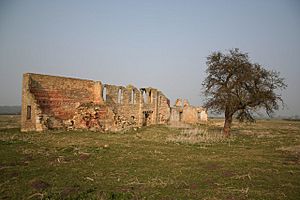Tupholme Abbey facts for kids
Quick facts for kids Tupholme Abbey |
|
|---|---|

Ruins of the Abbey
|
|
| Location | Tupholme, Lincolnshire, England |
| Founder | Gilbert and Alan de Neville |
| Built | from 1155 to 1165 |
| Original use | Abbey |
| Architectural style(s) | Medieval |
| Governing body | Historic England |
| Owner | Heritage Trust of Lincolnshire |
|
Listed Building – Grade I
|
|
| Designated | 25 January 1927 |
Tupholme Abbey was a special kind of monastery called a Premonstratensian abbey. It was built near the River Witham, about 10 miles east of Lincoln, in England. The area around the River Witham in Lincolnshire had many monasteries. This was because the river was useful for transport and for trading wool.
Most of Tupholme Abbey was destroyed around 1538. This happened during Henry VIII's time, when many monasteries were closed in England. Today, you can visit the ruins of Tupholme Abbey. It is a Grade I listed building, meaning it's very important. Heritage Lincolnshire looks after it. You can visit for free from morning until evening.
Contents
What's in a Name? Tupholme's Story
The name Tupholme shows how Scandinavian languages influenced England. This happened during a time called Danelaw (from the 9th to 11th centuries). The name basically means 'an island where male sheep (rams) lived'.
The word 'Tupp' means a male sheep. It was used in northern Britain long ago. It might be linked to the Swedish word 'tupp' for a male chicken. The 'holme' part comes from an old Norse word 'holmr'. This word means 'island'. It tells us the abbey was once on an island in a wet, marshy area. Later, these wet lands were drained for farming.
Who Were the Premonstratensians?
The Premonstratensians were a religious order founded in 1120. They were started by Saint Norbert of Xanten in Prémontré, France. They are also known as the Norbertines or the White Canons. They are different from monks. They are called Canons Regular.
Like monks, Canons Regular live together in a community. They also pray together. But unlike monks, Canons Regular focus a lot on preaching. They also help people in their local communities. The Premonstratensian order was approved by Pope Honorius II in 1126.
At first, they had only nine houses. But by the mid-1300s, they had about 1,300 monasteries for men. They also had 400 for women across Europe. The order came to England around 1143. Their first house was Newsham Abbey in Lincoln. By the early 1500s, they had 35 houses in England. They also had houses in Scotland and Ireland. All of them, like Tupholme Abbey, were closed during the Protestant Reformation.
In the Middle Ages, Lincolnshire had many people living there. It also had nine Premonstratensian houses. Besides Tupholme Abbey, these included Barlings Abbey and Newsham Abbey.
Building Tupholme Abbey
Tupholme Abbey was built to honor the Annunciation. It was founded between 1155 and 1165. Two men, Gilbert and Alan de Neville, asked the Premonstratensians to build it.
An abbot (the head of the abbey) and twelve canons came from Newsham Abbey to start the community. The abbey was given land in Tupholme and other smaller areas. It also received control of churches in places like Burreth and Ranby.
Later, in 1329, Henry, Earl of Lancaster gave the abbey more land. In 1342, Ralf de Neville also donated land.
Tupholme Abbey was never a very rich place. In 1347, the abbey was in a lot of debt. Records from later years show some problems. For example, in 1482, the canons (the religious men living there) were not allowed to leave the abbey without permission. They were also told not to drink late at night after the last prayer service. If they broke these rules, they would have to eat only bread and water for three days.
Despite these few problems, the abbey spent almost 400 years focused on prayer. They also helped the local people and cared for the poor.
Tupholme was a small abbey. Because of this, it was one of the first to be closed. This happened in 1536 during the Dissolution of the Monasteries. The abbey's income in 1534 was about £100. The last abbot, John Ancaster, received a pension of £18. Eight other canons each received £1. This was a normal amount at the time.
Leaders of Tupholme Abbey
Here are some of the abbots who led Tupholme Abbey:
- Ivo (late 1100s)
- Geoffrey (1202-1230)
- Thomas (1276-1289)
- Ralf (elected 1293)
- William (elected 1310)
- Roger (around 1348)
- Simon of Lincoln (elected 1349)
- John of Beseby (elected 1373)
- William of Tynton (elected 1383)
- John Spalding (died 1456)
- John Coventry (elected 1456)
- John Ancaster (mentioned 1474)
- Thomas Sotby (1488-1491)
- Thomas Gryme (1494-1509)
- John Sword (mentioned 1522)
- John Ancaster (last abbot, mentioned 1529)
Nature Around the Abbey
The abbey grounds have several fruit trees, including apple and bullace trees. The many ponds are home to lots of wildlife. You can find plants like fine-leaved water dropwort and animals like the great crested newt. The nearby Southrey Wood is also full of forest wildlife.
Sheep have lived in the Tupholme area for thousands of years. Their grazing and dung help certain plants grow, like stinging nettles and thistles.
Images for kids


